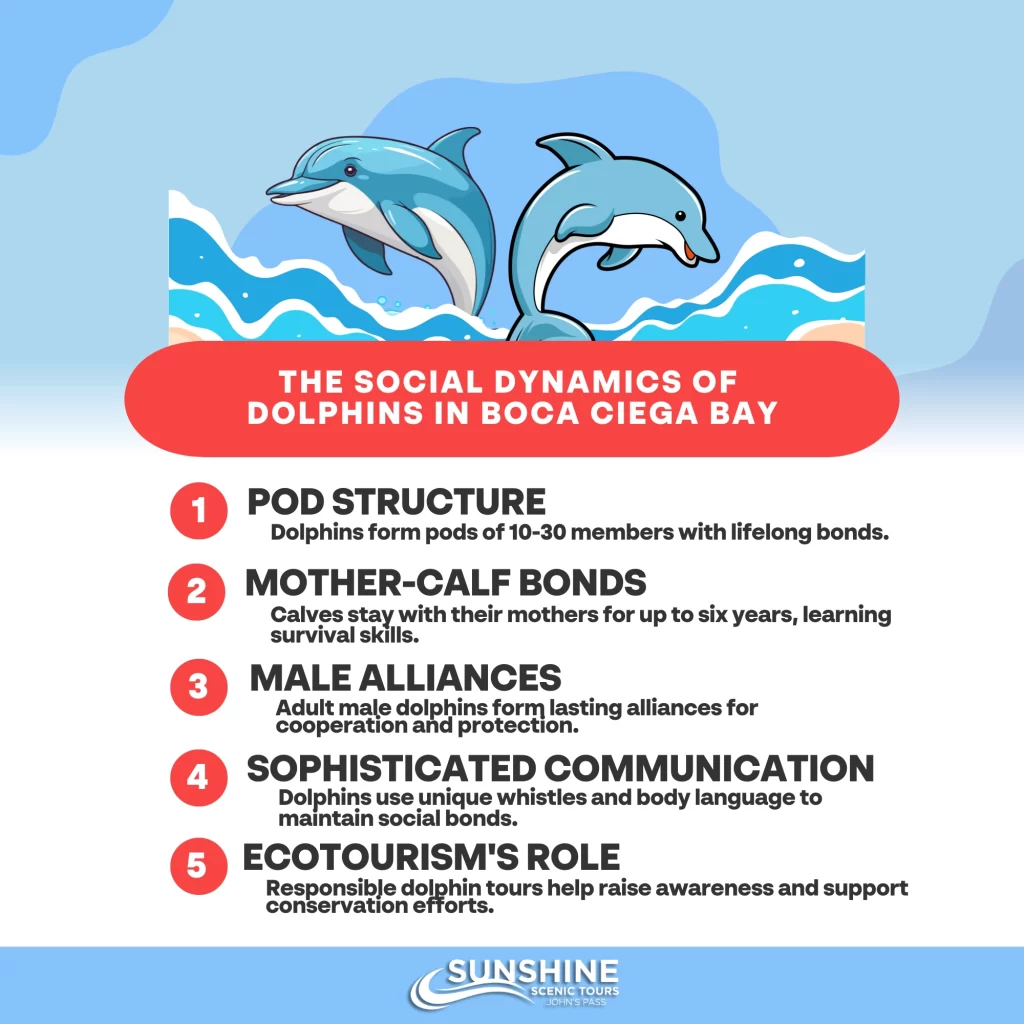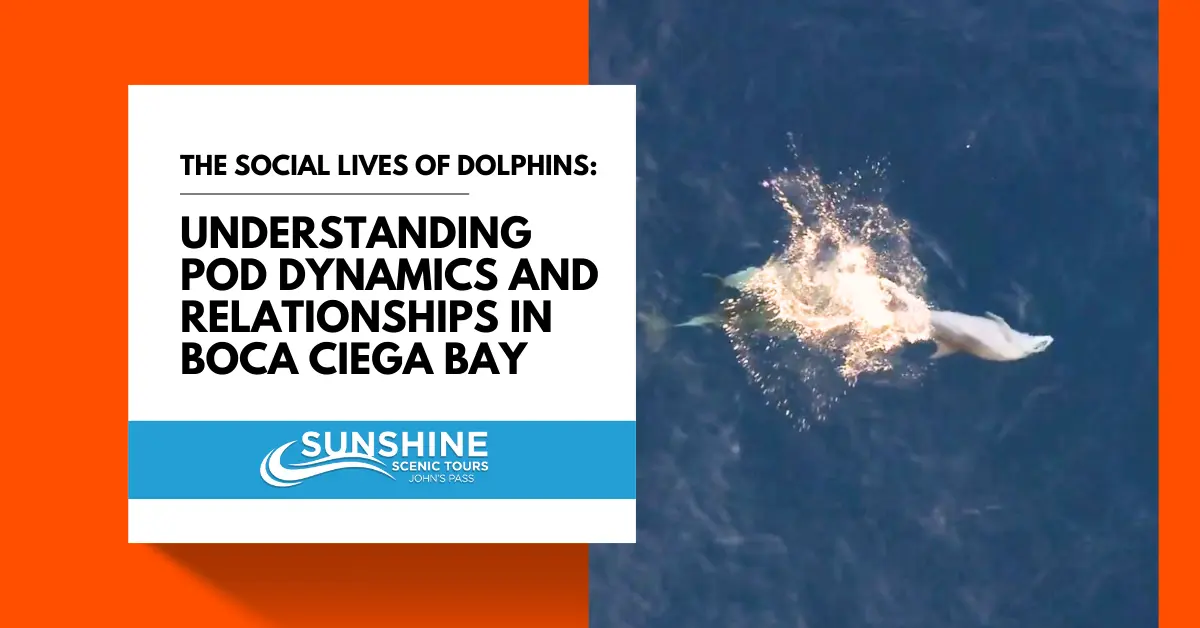Boca Ciega Bay, nestled along the Gulf Coast of Florida, is not just a picturesque waterway; it’s a thriving habitat for one of the most socially complex and intelligent creatures on the planet: the Atlantic Bottlenose dolphin. These graceful marine mammals have long fascinated scientists and nature lovers alike, not just for their playful antics but for the intricate social lives they lead.

Key Takeaways:
- Pod Dynamics: Dolphin pods in Boca Ciega Bay typically consist of 10 to 30 individuals, forming close-knit groups with strong, lifelong bonds.
- Complex Relationships: Dolphins establish relationships beyond family ties, with mothers and calves showing particularly strong bonds, while adult males often form lasting alliances.
- Communication and Cooperation: Dolphins use sophisticated communication methods and cooperate in activities like hunting, showcasing their intelligence and social strategies.
- Human Interaction: Responsible ecotourism, such as Dolphin Quest, helps raise awareness about the need to protect dolphin habitats while allowing people to observe these magnificent creatures up close.
Let’s dive deep into the world of dolphin pod dynamics and relationships, with a special focus on the bottlenose dolphins of Boca Ciega Bay. We’ll also explore how Dolphin Quest, one of the premier tours operated by Sunshine Scenic Tours, offers a unique opportunity to observe these fascinating creatures in their natural environment.
The Social Structure of Dolphin Pods
Dolphins are highly social animals, and their lives revolve around the pod, a close-knit group that typically consists of 10 to 30 individuals, though some superpods can number in the hundreds. The bonds within these pods are incredibly strong, often lasting a lifetime. These relationships are not just based on family ties but also on friendships formed through mutual cooperation and shared experiences.
In Boca Ciega Bay, these pods are a common sight. The bay’s rich and diverse ecosystem provides an ideal environment for dolphins to thrive. The shallow waters and abundant fish populations make it a perfect hunting ground, while the bay’s sheltered nature offers a safe haven for dolphins to socialize, mate, and raise their young.
Understanding Dolphin Relationships
Dolphin relationships are complex and multifaceted. Within a pod, dolphins form smaller subgroups based on age, sex, and familial connections. Mothers and calves have a particularly strong bond, with calves staying close to their mothers for up to six years. During this time, the mother teaches the calf everything it needs to know about survival, from hunting techniques to social behaviors.
In Boca Ciega Bay, observers often see mother-calf pairs swimming in close proximity, the calf mimicking the mother’s movements as it learns the ropes of dolphin life. These pairs are an essential part of the social fabric of the pod, with other pod members often taking on protective roles to ensure the calf’s safety.
During the spring and summer months, it isn’t uncommon to see a mother and her calf from aboard the Dolphin Quest!
But dolphin relationships extend beyond just mother and calf. Adult males, for example, often form alliances with one another, sometimes lasting decades. These male alliances are typically formed between two to three individuals and are used to cooperate in hunting and protecting the group. In some cases, these alliances work together to compete for access to females, showcasing the complexity of dolphin social strategies.
Communication and Cooperation
Communication is key to maintaining the complex social structures of dolphin pods. Dolphins use a variety of sounds, including clicks, whistles, and body movements, to convey information and maintain social bonds. Each dolphin has a unique signature whistle, which acts like a name, allowing individuals to recognize and call out to each other even across long distances.
In the clear waters of Boca Ciega Bay, these communication methods are on full display. Passengers aboard Dolphin Quest often have the chance to watch as the dolphins play, hunt, and relax with each other. These vocalizations are not just random noises; they are a sophisticated form of communication that conveys everything from an individual’s identity to warnings about nearby predators or calls to gather for hunting.
Cooperation within the pod is another critical aspect of dolphin social life. Dolphins work together in a variety of ways, from hunting in coordinated groups to assisting in the care of each other’s young. One of the most fascinating cooperative behaviors is the practice of “fish herding,” where dolphins work together to corral schools of fish into tight clusters, making it easier to catch them. In Boca Ciega Bay, this behavior is a common sight, as the bay’s shallow waters make it an ideal hunting ground for this type of group cooperation. Often, dolphins will make use of the Bay’s artificial retaining walls to assist in catching their prey.
Social Play and Learning
Play is an essential part of dolphin social life, and it serves multiple purposes. Through play, dolphins strengthen social bonds, practice hunting techniques, and learn the intricacies of social hierarchies within the pod. Young dolphins are particularly playful, often seen leaping out of the water, chasing each other, and engaging in mock battles. These playful behaviors are not just for fun; they are critical for the development of young dolphins, helping them to learn essential survival skills.
In Boca Ciega Bay, the playful nature of dolphins is a frequent highlight for those on Dolphin Quest. Watching a pod of dolphins engage in playful antics is not just entertaining; it’s a window into the developmental stages of these intelligent creatures.
The Impact of Human Interaction
While dolphins in Boca Ciega Bay have adapted well to their environment, they still face challenges, particularly from human activities. Boat traffic, pollution, and habitat destruction are significant threats to dolphin populations. However, responsible ecotourism, like the Dolphin Quest tour, plays an essential role in raising awareness and promoting conservation efforts.
Sunshine Scenic Tours is committed to ensuring that their tours have a minimal impact on the local dolphin populations. By following strict guidelines, they ensure that the dolphins are not disturbed or stressed by human interaction. Instead, these tours provide an educational experience that highlights the importance of protecting these magnificent creatures and their habitat.
Conclusion
There’s no better way to appreciate the social complexity and beauty of dolphins than by observing them in their natural habitat. Boca Ciega Bay offers a unique glimpse into the lives of these intelligent and social creatures, where you can witness firsthand the intricate dynamics of dolphin pods. Whether it’s the strong bonds within the pod, the sophisticated communication methods, or the cooperative hunting strategies, dolphins exemplify the wonders of marine life.
By choosing to embark on a Dolphin Quest tour with Sunshine Scenic Tours, you not only get the chance to see these magnificent creatures up close, but you also contribute to their conservation. The responsible and educational approach of these tours ensures that the dolphins are respected and protected, allowing future generations to continue marveling at their social lives.
For a full schedule of daily cruises and to book your tour, visit www.boattoursjohnspass.com. Experience the magic of Boca Ciega Bay and the incredible world of dolphins that call it home.











